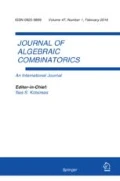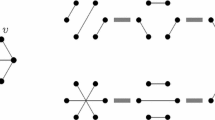Abstract
We prove the alternating sign conjecture for the perfect matching derangement graph.
Similar content being viewed by others
Data Availability Statement
Data sharing is not applicable to this article as no datasets were generated or analyzed during the current study.
Notes
The use of the word ‘derangement’ in this context is somewhat awkward, but now standard. One can draw an analogy between the graph \(\Gamma _{2n}\) and the derangement graph, whose vertices are the set of permutations on an n element set, and whose edges are pairs \(\{\pi ,\sigma \}\) of permutations that are derangements of one another, meaning that, in one-line notation, \(\pi \) and \(\sigma \) disagree in every position. In that sense, one could say that \(\pi \) and \(\sigma \) do not intersect. Similarly, if two perfect matchings M and \(M'\) do not intersect, it is said that M and \(M'\) are derangements of one another.
See, e.g., [7], and references therein, as well as the bibliography below.
For a beautiful introduction to this constellation of ideas, see [1].
Actually, Okounkov and Olshanski discuss only Jack polynomials, which they write as \(P_\mu (x;\theta )\). Here, \(\theta =1/\alpha \), where \(\alpha \) is the usual Jack parameter. But Macdonald and Stanley show (see, e.g., [16], Proposition 1.2 or [10], p. 408) that the zonal polynomials are obtained from the Jack polynomials by setting \(\alpha =2\). For this reason, we call \(P_\mu (x;\frac{1}{2})\) zonal polynomials.
Note that \(a'(\square )\) and \(\ell '(\square )\) are computed relative to the origin of \(\mu \). Note also that, to be consistent with the initial condition, we must set \(\langle z\rangle _\varnothing =\psi _\varnothing =1\).
References
Godsil, C., Meagher, K.: Erdős-Ko-Rado Theorems: Algebraic Approaches. Cambridge University Press, Cambridge (2016)
Godsil, C., Meagher, K.: An algebraic proof of the Erdős-Ko-Rado theorem for intersecting families of perfect matchings. Ars. Math. Contemp. 12, 205–217 (2017)
James, A.T.: Distributions of matrix variables and latent roots derived from normal samples. Ann. Math. Stat. 35, 475–501 (1964)
Knop, F., Sahi, S.: Difference equations and symmetric polynomials defined by their zeros. Internat. Math. Res. Notices 10, 473–486 (1996)
Ku, C.-Y., Wales, D.: Eigenvalues of the derangement graph. J. Comb. Theory Ser. A 117(3), 289–312 (2010)
Ku, C.-Y., Wong, K.-B.: Solving the Ku-Wales conjecture on the eigenvalues of the derangement graph. European J. Comb. 34(6), 941–956 (2013)
Ku, C.-Y., Wong, K.-B.: Eigenvalues of the matching derangement graph. J. Algebraic Combin. 48, 627–646 (2018)
Ku, C.-Y., Wong, K.-B., Koh, S.: Alternating sign property of the matching derangement graph, preprint of June 9, (2021)
Lindzey, N.: Erdős-Ko-Rado for perfect matchings. European J. Combin. 65, 130–142 (2017)
Macdonald, I.G.: Symmetric Functions and Hall Polynomials, 2nd edn. Oxford University Press, Oxford (1995)
Meagher, K., Moura, L.: Erdős-Ko-Rado theorems for uniform set-partition systems, Electron. J. Combin., 12, (2005), #R40
Okounkov, A.: (Shifted) Macdonald polynomials: \(q\)-integral representation and combinatorial formula. Compositio Math. 112, 147–182 (1998)
Okounkov, A., Olshanski, G.: Shifted Jack polynomials, binomial formula, and applications. Math. Res. Lett. 4, 69–78 (1997)
Renteln, P.: On the spectrum of the derangement graph, Electron. J. Combin., 14 (2007), #R82
Sahi, S.: Interpolation, integrality, and a generalization of Macdonald’s polynomials. Math. Res. Notices 10, 457–471 (1996)
Stanley, R.P.: Some combinatorial properties of Jack symmetric functions. Adv. Math. 77, 76–115 (1989)
Stanley, R.P.: Enumerative Combinatorics, vol. 2. Cambridge University Press, Cambridge (1999)
Author information
Authors and Affiliations
Corresponding author
Additional information
Publisher's Note
Springer Nature remains neutral with regard to jurisdictional claims in published maps and institutional affiliations.
Rights and permissions
About this article
Cite this article
Renteln, P. On the spectrum of the perfect matching derangement graph. J Algebr Comb 56, 215–228 (2022). https://doi.org/10.1007/s10801-021-01105-y
Received:
Accepted:
Published:
Issue Date:
DOI: https://doi.org/10.1007/s10801-021-01105-y



